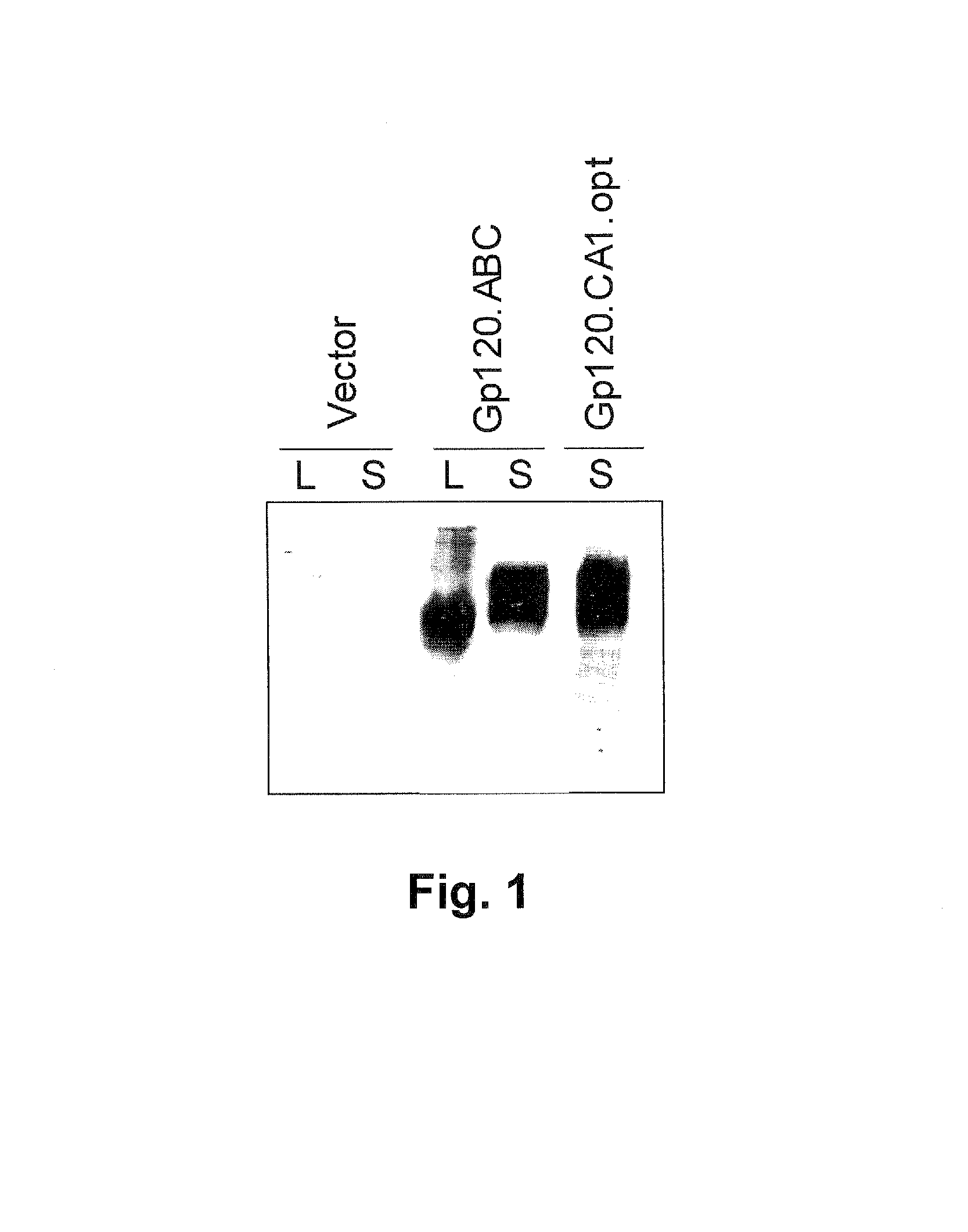Recombinant HIV-1 gp120 immunogen with three different V3 loops from viruses of different clades
a technology of v3 loops and hiv-1, applied in the field of biochemistry and medicine, can solve the problems of largely haphazard matter of chance induction of broadly neutralizing anti-hiv-1 antibodies and more broadly neutralizing anti-v3 antibodies via immunization of animals and humans, and achieve the effect of expanding the breadth of neutralizing antibodies
- Summary
- Abstract
- Description
- Claims
- Application Information
AI Technical Summary
Benefits of technology
Problems solved by technology
Method used
Image
Examples
example i
Methods
[0087]Female New Zealand rabbits (2 kg) receives three monthly DNA immunizations by gene gun. Each shot delivers 1 μg of DNA and a total of 36 non-overlapping shots are delivered to each rabbit at each of the three time points at the surface of shaved abdominal skin after animals are anesthetized according to IACUC approved protocols. The serum samples are collected immediately before, and 2 weeks after each immunization.
ELISA (Enzyme-Linked Immunosorbent Assay).
[0088]Rabbit serum samples are tested for gp120-specific and for V3 peptide-specific IgG antibody responses by ELISA. Microplates are coated with ConA (5 μg / well) for 1 hour and then washed 5 times with washing buffer (PBS at pH 7.2 with 0.1% Triton X-100). gp120 at 1 μg / ml is added (100 μl for each well) and incubated for 1 hour at room temperature. Alternatively, V3 peptides or other recombinant proteins containing V3 sequences are coated directly onto microplates (see Gomy et al., 2002, 2004, supra)...
example ii
Assaying Protective Immunity
[0102]The efficacy of any DNA vaccine of the present invention can be tested in an appropriate animal model. Preferably, responses in animals that can be infected by HIV are tested, such as a non-human primate (e.g., a chimpanzee) or an animal such as a mouse which has circulating human immune cells. Large enough numbers of animals are be used to achieve statistical significance, though in the case of non-human primates, the numbers may be limited and thus the experiments may be need to be repeated in the same animal, for example. Once the test animals are vaccinated and control animals are vaccinated with a negative control containing the same vector, but without the heterologous gp120 DNA, both groups of animals are then infected with HIV-1. They may be infected with primary isolates or with laboratory strains, or both (or SHIV, in the case of macaque experiments). After a suitable amount of time, at which the animals vaccinated with a negative control ...
example iii
Priming with gp120ABC DNA Induces Increased Antibody Titers
[0114]Rabbits were immunized with either codon optimized CA1 gp120 DNA immunogen or the recombinant gp120-ABC DNA immunogen of the invention in which V1 / V2 was replaced by the Clade A consensus V3 loop sequence, V3 was replaced by a Clade B consensus V3 loop sequence and V4 was replaced by a Clade C consensus V3 loop sequence as described above (as in SEQ ID NO:8). As noted gp120-CA1 is the original amino sequence of gp120-CA1 of clade A.
[0115]The immunizing dose was given twice, 36 μg of either gp120-CA1 or gp120-ABC DNA. Boosting was with fusion proteins of V3 from clades A1, B and C (100 μg each).
[0116]Sera from immunized rabbits was tested for neutralization of pseudoviruses with consensus V3 sequences in the SF162 gp120 backbone. Results are shown in Table below.
[0117]
TABLE 5Neutralization of Pseudoviruses withConcensus V3 Sequences in SF162 gp120backbone (Neutralizing titer)PrimingBoostSF 162Clade AClade AClade C -DNAP...
PUM
| Property | Measurement | Unit |
|---|---|---|
| time | aaaaa | aaaaa |
| time | aaaaa | aaaaa |
| pH | aaaaa | aaaaa |
Abstract
Description
Claims
Application Information
 Login to View More
Login to View More - R&D
- Intellectual Property
- Life Sciences
- Materials
- Tech Scout
- Unparalleled Data Quality
- Higher Quality Content
- 60% Fewer Hallucinations
Browse by: Latest US Patents, China's latest patents, Technical Efficacy Thesaurus, Application Domain, Technology Topic, Popular Technical Reports.
© 2025 PatSnap. All rights reserved.Legal|Privacy policy|Modern Slavery Act Transparency Statement|Sitemap|About US| Contact US: help@patsnap.com



